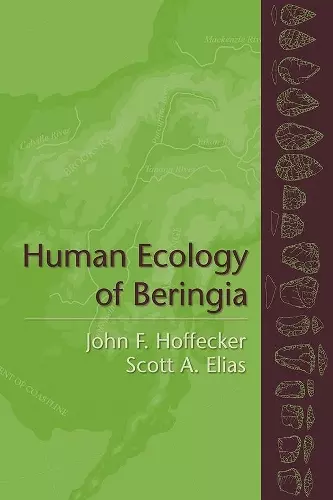Human Ecology of Beringia
John F Hoffecker author Scott A Elias author
Format:Hardback
Publisher:Columbia University Press
Published:6th Jul '07
Currently unavailable, and unfortunately no date known when it will be back

"An original combination of facts and arguments, this book will find a real welcome not only among individuals interested specifically in the northern world of which Beringia was a part, but also in the plentiful number of those who are concerned with the initial peopling of the Americas." -- Don Dumond, professor emeritus of anthropology, the University of Oregon
Humans first occupied Beringia during a twilight period when rising sea levels had not yet caught up with warming climates. This volume synthesizes research on the archaeological sites and changing climates and biota of the period. It also traces the evolving adaptations of early humans to the cold environments of northern Eurasia.Twenty-five thousand years ago, sea level fell more than 400 feet below its present position as a consequence of the growth of immense ice sheets in the Northern Hemisphere. A dry plain stretching 1,000 miles from the Arctic Ocean to the Aleutians became exposed between northeast Asia and Alaska, and across that plain, most likely, walked the first people of the New World. This book describes what is known about these people and the now partly submerged land, named Beringia, which they settled during the final millennia of the Ice Age. Humans first occupied Beringia during a twilight period when rising sea levels had not yet caught up with warming climates. Although the land bridge between northeast Asia and Alaska was still present, warmer and wetter climates were rapidly transforming the Beringian steppe into shrub tundra. This volume synthesizes current research-some previously unpublished-on the archaeological sites and rapidly changing climates and biota of the period, suggesting that the absence of woody shrubs to help fire bone fuel may have been the barrier to earlier settlement, and that from the outset the Beringians developed a postglacial economy similar to that of later northern interior peoples. The book opens with a review of current research and the major problems and debates regarding the environment and archaeology of Beringia. It then describes Beringian environments and the controversies surrounding their interpretation; traces the evolving adaptations of early humans to the cold environments of northern Eurasia, which set the stage for the settlement of Beringia; and provides a detailed account of the archaeological record in three chapters, each of which is focused on a specific slice of time between 15,000 and 11,500 years ago. In conclusion, the authors present an interpretive summary of the human ecology of Beringia and discuss its relationship to the wider problem of the peopling of the New World.
This excellent summary and evaluation... should serve as the baseline of interpretation for many years to come... Highly recommended. Choice A concise and readable account of the environmental setting and peopling of the far northern reached of the two continents -- Becky M. Saleeby Ecology Thorough and thought-provoking... a must-have reference. -- Kelly E. Graf Journal of Anthropological Research An original and unparalleled summary of the pre-Holocene archeology and environment of this unique and pivotal region. -- Ben Fitzhugh Human Ecology Useful to students and professionals alike. -- Raymond Le Blanc Artic Hoffecker and Elias' well-written volume is a thorough discussion of the landscape, climate, vegetation, and fauna of what was once Beringia as well as a more than adequate discussion of sites, artefact complexes and their places in Northeast Asia and Alaska. It provides good coverage for both the interested layman and the professional investigator. -- Robert E. Ackerman Antiquity
- Winner of Choice Outstanding Academic Title 2008
ISBN: 9780231130608
Dimensions: unknown
Weight: unknown
304 pages